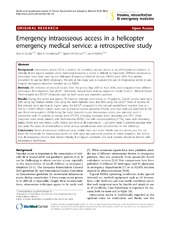| dc.contributor.author | Sunde, Geir Arne | en_US |
| dc.contributor.author | Heradstveit, Bård E. | en_US |
| dc.contributor.author | Vikenes, Bjarne H. | en_US |
| dc.contributor.author | Heltne, Jon-Kenneth | en_US |
| dc.date.accessioned | 2011-04-11T09:15:28Z | |
| dc.date.available | 2011-04-11T09:15:28Z | |
| dc.date.issued | 2010-10-07 | eng |
| dc.identifier.issn | 1757-7241 | |
| dc.identifier.uri | https://hdl.handle.net/1956/4646 | |
| dc.description.abstract | Intraosseous access (IO) is a method for providing vascular access in out-of-hospital resuscitation of critically ill and injured patients when traditional intravenous access is difficult or impossible. Different intraosseous techniques have been used by our Helicopter Emergency Medical Services (HEMS) since 2003. Few articles document IO use by HEMS physicians. The aim of this study was to evaluate the use of intraosseous access in pre-hospital emergency situations handled by our HEMS. Methods We reviewed all medical records from the period May 2003 to April 2010, and compared three different techniques: Bone Injection Gun (B.I.G® - Waismed), manual bone marrow aspiration needle (Inter V - Medical Device Technologies) and EZ-IO® (Vidacare), used on both adults and paediatric patients. Results During this seven-year period, 78 insertion attempts were made on 70 patients. Overall success rates were 50% using the manual needle, 55% using the Bone Injection Gun, and 96% using the EZ-IO®. Rates of success on first attempt were significantly higher using the EZ-IO® compared to the manual needle/Bone Injection Gun (p < 0.01/p < 0.001). Fifteen failures were due to insertion-related problems (19.2%), with four technical problems (5.1%) and three extravasations (3.8%) being the most frequent causes. Intraosseous access was primarily used in connection with 53 patients in cardiac arrest (75.7%), including traumatic arrest, drowning and SIDS. Other diagnoses were seven patients with multi-trauma (10.0%), five with seizures/epilepsy (7.1%), three with respiratory failure (4.3%) and two others (2.9%). Nearly one third of all insertions (n = 22) were made in patients younger than two years. No cases of osteomyelitis or other serious complications were documented on the follow-up. Conclusions Newer intraosseous techniques may enable faster and more reliable vascular access, and this can lower the threshold for intraosseous access on both adult and paediatric patients in critical situations. We believe that all emergency services that handle critically ill or injured paediatric and adult patients should be familiar with intraosseous techniques. | en_US |
| dc.language.iso | eng | eng |
| dc.publisher | BioMed Central | eng |
| dc.rights | Attribution CC BY | eng |
| dc.rights.uri | http://creativecommons.org/licenses/by/2.0 | eng |
| dc.title | Emergency intraosseous access in a helicopter emergency medical service: a retrospective study | en_US |
| dc.type | Peer reviewed | |
| dc.type | Journal article | |
| dc.description.version | publishedVersion | en_US |
| dc.rights.holder | Copyright 2010 Sunde et al; licensee BioMed Central Ltd. | |
| dc.rights.holder | Sunde et al. | |
| dc.source.articlenumber | 52 | |
| dc.identifier.doi | https://doi.org/10.1186/1757-7241-18-52 | |
| dc.identifier.cristin | 521204 | |
| dc.source.journal | Scandinavian Journal of Trauma, Resuscitation and Emergency Medicine | |
| dc.source.40 | 18 | |
| dc.subject.nsi | VDP::Medical disciplines: 700 | eng |

